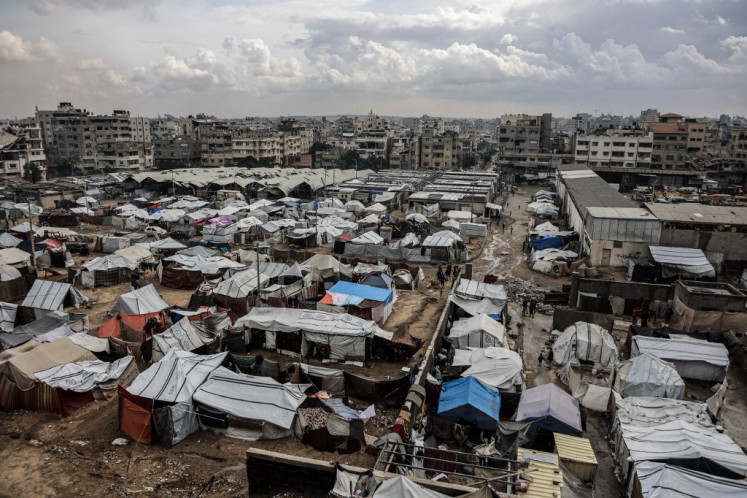Popular Reads
Top Results
Can't find what you're looking for?
View all search resultsPopular Reads
Top Results
Can't find what you're looking for?
View all search resultsUrbanization and urban development patterns
The 2010 census shows that Indonesia’s total population increased from 203
Change text size
Gift Premium Articles
to Anyone
T
he 2010 census shows that Indonesia’s total population increased from 203.5 million to 237.6 million in the last 10 years, and the urban population grew from 85.2 million to 118.3 million during the same period.
Likewise, the proportion of the urban population, that is, level of urbanization, increased significantly from 41.9 percent to 49.7 percent over the period.
In other words, about half of Indonesia’s population is urban. About 80.5 million out of this urban population, or 68 percent, live in Java, and 37.8 million live on other islands.
It can be said that in most parts of the country urbanization and urban development have been greatly fueled by foreign and domestic investment, especially in large cities like Jakarta, Surabaya, Bandung and Medan.
Economic activities have been increasingly concentrated in those cities, most notably the manufacturing, finance, services, property and trade sectors.
The population growth rate increased from 1.35 percent per year between 1990 and 2000 to 1.49 percent between 2000 and 2010, but the annual urban-population growth rate, which had reached 4.40 percent in the period of 1990–2000, declined significantly to 3.33 percent over the period of 2000–2010.
Meanwhile, the urban-population growth in Java hit 3.17 percent in 2000–2010, whereas in the outer islands the rate was significantly higher at 3.66 percent.
The number of cities with million-plus populations has increased tremendously. In 1950, Jakarta was the only city with a population of more than 1 million.
By 1980, Surabaya, Bandung and Medan joined this rank, but by 2010 the figure had increased to 10, including Palembang, Semarang, Tangerang, Depok, Bekasi and Makassar.
It should be noted, however, that four of those million-plus cities; Jakarta, Tangerang, Bekasi and Depok, are located within the Jakarta Metropolitan area or Jabodetabek.
It is estimated that about one-fifth of Indonesia’s urban population is concentrated in this metropolitan region.
The population census data also shows that the rate of annual population growth of the million-plus cities is lower than the national average population-growth rate of 1.49 percent, with the exception of Bekasi (3.44 percent), Tangerang (3.20 percent), Depok (4.25 percent) and Makassar (2.07 percent).
How can the low growth rates of other million-plus cities, including Jakarta, Surabaya, Bandung and Medan, be explained? It is due to suburbanization, which has resulted in faster growth rates in the outskirts of metropolitan areas adjacent to the core cities.
Take the example of Bandung metropolitan area, where the rate of annual population growth of Bandung City, the core, was only 1.11 percent over the period 2000–2010, compared to the adjacent areas; Bandung regency (2.5 percent), Cimahi (2.06 percent) and West Bandung regency (1.99 percent). Likewise, the cities of Bekasi, Tangerang and Depok have annual population-growth rates much higher than the city of Jakarta.
It should be kept in mind, however, that high population growth rates in the areas adjacent to the city of Jakarta are not entirely as a result of migration, but partly due to the reclassification of previously rural areas as urban in the 2010 census.
The spatial dimension of urban development in Java basically has taken the form of an urban belt connecting large cities and consisting of highly networked cities of different sizes, including Jakarta-Bandung; Surabaya-Malang; Semarang-Yogyakarta; Cirebon-Semarang.
A notable characteristic of these urban belts is the increasing mixtures of industrial, economic and agricultural activities, and the blurring of the distinction between “urban” and “rural” in the region both physically and socioeconomically.
What happened to small and medium cities, those with population sizes of 100,000 to a million? The traditional role of small towns in Java as centers for the distribution and collection of goods has declined.
In fact, the annual rate of growth of small and medium towns in Java is far below the national annual population growth between 2000 and 2010.
In contrast, small and medium urban centers in other parts of Indonesia are experiencing a faster population growth than those in Java.
Batam city in Riau Islands, for example, scored the highest population growth among urban centers in Indonesia with 11.7 percent.
Other extremely high population growth rates are shown by the cities of Sorong (9.73 percent); Jayapura (6.50 percent); Tarakan (6.35 percent); Pekanbaru (5.42 percent); Denpasar (5.08 percent); Dumai (4.67 percent); Kendari (4.46 percent); Bontang (4.36 percent); Samarinda (3.95 percent) and Balikpapan (3.71 percent).
In the case of Batam, the city has experienced a large influx of migrants from all over the country, most notably from Java and other parts of Sumatra.
In general, this suggests that small and medium cities outside Java play a more important role as centers of economic activities, including natural resource exploitation, such as mining, oil and timbers, than those in Java.
In conclusion, the urban population in Indonesia has been growing rapidly but is still heavily concentrated in Java, with a share of 68 percent, although slightly declining from the previous decade which reached 69.1 percent.
Urbanization and urban development in Indonesia are centered in large cities, notably Greater Jakarta.
Nevertheless, small towns and medium cities on the outer islands are growing more rapidly than those in Java, suggesting that those outside Java play a more significant role as centers of economic activity.
From the urban-development and urban-planning perspective, this situation calls for an explicit national urban-development policy that should be implemented consistently, focusing on stimulating development of cities in the outer islands to become new growth centers, so that urban development and urbanization can be more evenly distributed.
The writer is a professor of urban and regional planning at Bandung Institute of Technology.










